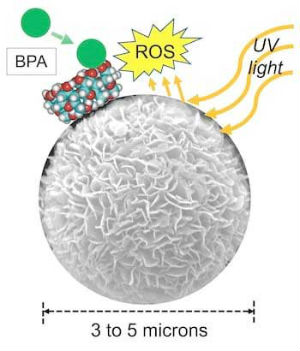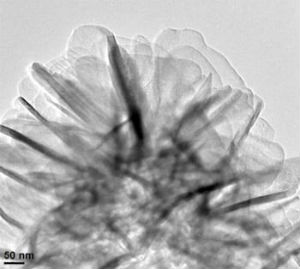|
NOVIDADES
Scientists have developed a human-friendly, ultra-flexible organic sensor powered by sunlight, which acts as a self-powered heart monitor. Previously, they developed a flexible photovoltaic cell that could be incorporated into textiles. In this study (Nature, Rice University scientists have developed something akin to the Venus’ flytrap of particles for water remediation. Micron-sized spheres created in the lab of Rice environmental engineer Pedro Alvarez are built to catch and destroy bisphenol A (BPA), a synthetic chemical used to make plastics. The research is detailed in the American Chemical Society journal Environmental Science & Technology ("Easily-recoverable, micron-sized TiO2 hierarchical spheres decorated with cyclodextrin for enhanced photocatalytic degradation of organic micropollutants").  Rice University researchers have enhanced micron-sized titanium dioxide particles to trap and destroy BPA, a water contaminant with health implications. Cyclodextrin molecules on the surface trap BPA, which is then degraded by reactive oxygen species (ROS) produced by the light-activated particles. Illustration by Danning Zhang
The good news is that reactive oxygen species (ROS) – in this case, hydroxyl radicals – are bad news for BPA. Inexpensive titanium dioxide releases ROS when triggered by ultraviolet light. But because oxidating molecules fade quickly, BPA has to be close enough to attack. That’s where the trap comes in. Close up, the spheres reveal themselves as flower-like collections of titanium dioxide petals. The supple petals provide plenty of surface area for the Rice researchers to anchor cyclodextrin molecules. Cyclodextrin is a benign sugar-based molecule often used in food and drugs. It has a two-faced structure, with a hydrophobic (water-avoiding) cavity and a hydrophilic (water-attracting) outer surface. BPA is also hydrophobic and naturally attracted to the cavity. Once trapped, ROS produced by the spheres degrades BPA into harmless chemicals. In the lab, the researchers determined that 200 milligrams of the spheres per liter of contaminated water degraded 90 percent of BPA in an hour, a process that would take more than twice as long with unenhanced titanium dioxide.  "Petals" of a titanium dioxide sphere enhanced with cyclodextrin as seen under a scanning electron microscope. When triggered by ultraviolet light, the spheres created at Rice University are effective at removing bisphenol A contaminants from water. Image: Alvarez Lab/Rice University
“Most of the processes reported in the literature involve nanoparticles,” said Rice graduate student and lead author Danning Zhang. “The size of the particles is less than 100 nanometers. Because of their very small size, they’re very difficult to recover from suspension in water.” The Rice particles are much larger. Where a 100-nanometer particle is 1,000 times smaller than a human hair, the enhanced titanium dioxide is between 3 and 5 microns, only about 20 times smaller than the same hair. “That means we can use low-pressure microfiltration with a membrane to get these particles back for reuse,” Zhang said. “It saves a lot of energy.” Because ROS also wears down cyclodextrin, the spheres begin to lose their trapping ability after about 400 hours of continued ultraviolet exposure, Zhang said. But once recovered, they can be easily recharged. “This new material helps overcome two significant technological barriers for photocatalytic water treatment,” Alvarez said. “First, it enhances treatment efficiency by minimizing scavenging of ROS by non-target constituents in water. Here, the ROS are mainly used to destroy BPA. “Second, it enables low-cost separation and reuse of the catalyst, contributing to lower treatment cost,” he said. “This is an example of how advanced materials can help convert academic hypes into feasible processes that enhance water security.” Rice University. Posted: Oct 05, 2018. |
|||||||||||||||||||||||||